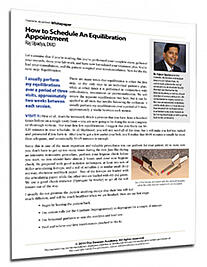 Occlusal equilibration plays an important role in a Complete Care Practice.
Occlusal equilibration plays an important role in a Complete Care Practice.Following proper diagnosis and treatment planning, occlusal equilibration can provide selected patients with the most conservative, predictable, and safest treatment possible. Occlusal equilibration can also help avoid the need for more complex treatments.
So you’ve performed your complete exam, gathered your records, done your lab work, and have now formulated your treatment plan. You’ve had your consultation, and the patient accepted your recommendation. Now for the next step: Equilibration. But how do you even schedule your patient for it?
In this whitepaper, Dr. Upadya goes over:
Download your free copy of "How to Schedule an Equilibration Appointment" today by filling out the form to the right.